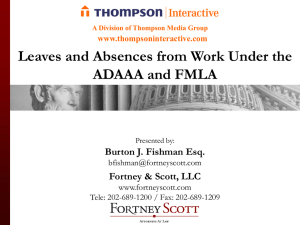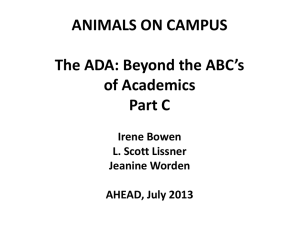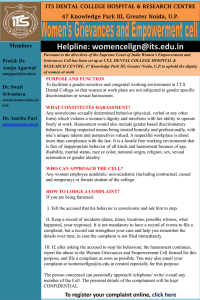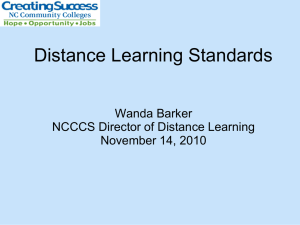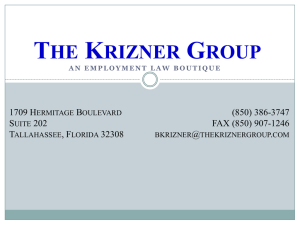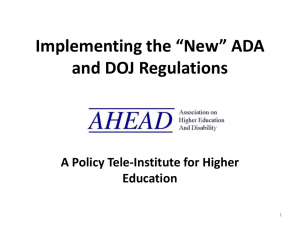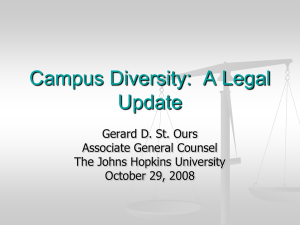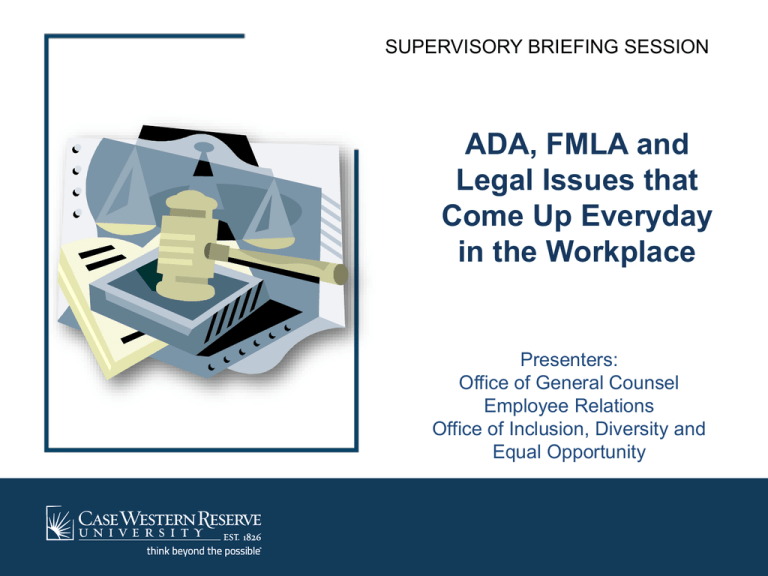
SUPERVISORY BRIEFING SESSION
ADA, FMLA and
Legal Issues that
Come Up Everyday
in the Workplace
Presenters:
Office of General Counsel
Employee Relations
Office of Inclusion, Diversity and
Equal Opportunity
Agenda
•
•
•
•
•
•
•
ADA/Accommodation Process
FMLA
Interaction of FMLA and ADA
Nursing Moms: Break times and
Lactation Rooms
Avoiding a Retaliation Claim
Addressing Harassment in the
Workplace
GINA
ADA/Accommodation Process
Melissa Burrows
Office of Inclusion, Diversity and Equal Opportunity
Americans with Disabilities Act (ADA)
The Americans with Disabilities Act of 1990 prohibits private
employers, state and local governments, employment agencies
and labor unions from discriminating against qualified individuals
with disabilities in job application procedures, hiring, firing,
advancement, compensation, job training, and other terms,
conditions, and privileges of employment. The law also requires
that covered entities provide qualified applicants and employees
with disabilities with reasonable accommodations that do not
impose undue hardship. An individual is considered to have a
disability if that individual either (1) has a physical or mental
impairment which substantially limits one or more of that person's
major life activities, (2) has a record of such an impairment, or (3) is
regarded as having such an impairment.
Online: https://www.case.edu/finadmin/humres/eod/disable.html
Accommodation Process
1. Employee contacts OIDEO requesting assistance due to
a disability;
2. Employee completes paperwork;
3. Employee submits paperwork, along with a doctor’s
note;
4. OIDEO contacts and negotiates employee’s request
with supervisor;
5. Request granted, modified or denied;
6. Employee and supervisor sent notification of outcome
based on request.
Accommodation Process
Date of Request:
Name:
_________________________
_____________________________________________________________________
Last Name
First Name
Position Title: ____________________________________________________________________
Department/Management Center:
__________________________________________________
Manager/Supervisor/Chair/Dean:____________________________________________________
Departmental HR Representative: ___________________________________________________
Home Address: __________________________________________________________________
_______________________________________Zip Code: ___________________
Home Phone:
( _____)____________________
Cell Phone:
(______)__________________
Campus Address:
_______________________________________________________________
Location Code:
_______________
Campus Phone:
(______)____________________
Email:
______________________@case.edu
How would you prefer to be contacted? Please select one.
Home Phone
Office Phone
Email
Cell Phone
Employment Classification – Please select one.
Full-time
Part-time Other __________________________________
Employment Category – Please select one.
Faculty
Staff
Accommodation Process
Doctor’s Note – Requested Information
1. Diagnosis
2. Status of condition (stable or changing)
3. Duration
4. Effects of diagnosis (review of job description based on
diagnosis by the doctor)
5. Recommended accommodation
6. Medication or treatment
Accommodation Process
Part B - Interview Questions: To be completed by the employee. This will be
reviewed during an in-person interview with the Faculty Diversity Officer or the EEO &
Diversity Specialist.
1. What is the nature of your disability, including your diagnosis?
2. Is this a permanent or temporary disability? If temporary, what is the duration of your
condition?
3. What work-related limitations caused by your disability are you currently
experiencing?
4. What are the essential functions of your job? If possible, please attach your current
job description.
5. Describe the accommodations you are requesting, including any adaptive equipment.
Be specific as possible.
6. Are you in need of an individual emergency evacuation plan? If so, please indicate
what accommodation you would need for this plan?
ADA Quiz Questions
True or False?
ADA Quiz # 1
True or False?
The purpose of the ADA is to guarantee jobs
to all people with disabilities.
ADA Quiz #2
True or False?
If you think an applicant/employee has a
disability, but it is not obvious, you should
always ask?
ADA Quiz #3
What is not considered a disability under the
ADA?
a. An applicant/employee with a broken leg
from a car wreck.
b. A cancer patient who is in remission.
c. An applicant/employee with a hearing
impairment.
d. An applicant/employee with epilepsy.
Family Medical Leave Act
Carolyn Washick
Human Resources
Family and Medical Leave Act (FMLA)
Quick Review
What criteria must an employee meet to be eligible
for FMLA?
How many weeks of unpaid leave does an eligible
employee receive?
What are reasons that an employee would take a
leave?
What is a intermittent leave of absence?
Tracking FMLA Leave
■ Employers still have obligation to track FMLA leave.
-- Failure to provide rights and designation notices may
constitute interference with FMLA rights.
-- Employers must make, keep and preserve records of
FMLA leave dates and notices provided for no less
than 3 years.
-- FMLA records must be kept as confidential ADA
disability records are. 29 CFR 825.500(g).
-- Remedies: lost compensation/benefits; actual
monetary losses, equitable relief (reinstatement,
promotion etc). 29 CFR 825.300(e); 825.301(e).
Why is Tracking FMLA Leave Important?
■ Unless an employee’s leave is designated as FMLA
leave, employee may be entitled to 12 weeks of leave
after designation (unless retroactively designated if
no harm to employee).
■ Employees can claim interference with an FMLA
leave if leave if not designated as required or adverse
action taken during a leave.
■ Tracking leave helps avoid a retaliation claim stating
that an adverse employment action was taken in
retaliation for taking an FMLA-protected leave
What do you think?
You hired a full time employee, Burt, in November
and he has a heart attack. What kind of leave is Burt
eligible to take?
Your other employee, Betty, who was hired 5 years
ago. She is pregnant and due in March. What kind
of leave of absence is she eligible to take?
If Betty was hired in November would she be eligible
to take a leave of absence?
Managing Intermittent FMLA Leave
• Can the university require certification from a health
care provider?
• Is a supervisor allowed to ask for a note from the
employees doctor each time an employee takes
intermittent FMLA days?
• If an employee’s appointments conflict with the
business needs can I deny the time off?
• What should I do if the employee takes more time
than the Certificate of Healthcare provider certifies?
• Can you call an employee at home when they are
on a leave of absence?
The Interaction of ADA and FMLA
in
Tracking Leave
ADA Accommodation Process
• What does the ADA require for determining
reasonable accommodations?
• If the supervisor has questions about complying with
ADA requirements regarding requests for
accommodations, where can I go to seek assistance?
Cases: Leave Extensions as Accommodations
•
•
Supervalu Inc. - agreed to pay $3.2 Million to former employees to
settle a lawsuit based on terminating employees with disabilities at
the end of medical leaves, instead of bringing them back with
reasonable accommodations. (2011)
Sears Roebuck & Co - agreed to pay $6.2 Million to former
employees who were automatically terminated after leaves expired.
•
•
Agreement required notification to employees on leave to inform the
workers about options to request a leave extension. (2009)
EEOC sued UPS for failure to consider leave extensions as a
disability accommodation for employees who could not return from
leave after 12 months (2011 – case dismissed on other grounds).
Positiveor
Corrective
ADA Leave
LeaveAction
Extension
Attendance(Cont.)
•
•
Modified work schedule can be ADA accommodation
(i.e. part-time). May be FMLA intermittent leave too.
A reasonable accommodation may be granting a leave
of providing an extension of medical leave of
absence.
•
Not have to provide indefinite leave.
•
Look at reasonableness of leave request under the
circumstances.
Refusal to grant additional leave time can be ADA
failure to accommodate.
May also result in ADA retaliation claims of leave or for
granting leave or extension to some and not others.
•
•
Interaction of FMLA and ADA
•
•
•
•
FMLA/Non-FMLA leave request may trigger ADA
accommodation process.
Employee does not have to say “FMLA leave” or ADA
accommodation is needed.
•Can say need “time off” or “need more time” to return to
job.
•Third person can make request.
If both apply, need to follow both process and document
both.
Before any employee is terminated for exceeding leave
limit, consider whether ADA accommodation applies too.
Interaction of FMLA and ADA
•
FMLA Leave Policy says:
If an employee is unable to return to work after 12 weeks,
employment with the University ends
with a voluntary
termination, unless employee has requested and is granted
additional leave time for a documented disability (via the disability
accommodation process by the IDEO Office), or is granted a nonFMLA leave.
•
Non-FMLA leave and ADA accommodation can be concurrent.
Nursing Moms:
Break Times and Lactation Rooms
Colleen Treml
Office of General Counsel
The Law on Lactation Rooms and Breaks
The Patient Protection and Affordable Care
Act amended the Fair Labor Standards Act to
require:
“reasonable” break times for an
employee to express breast milk for her
nursing child
A place where an employee can express
milk
Requirements for Breaks
For expressing milk for nursing child for 1
year after birth.
Whenever mother has need for break.
For as long as needed to express milk.
Only applies to non-exempt employees
Breaks can be unpaid if other breaks are
unpaid.
Must be completely relieved of duties.
Requirements for Lactation Rooms
Rooms for expressing milk must be:
A place other than a bathroom
Shielded from view
Free from intrusion from co-workers and
the public
Who to Call for Questions
Need to provide breaks and room upon
request.
If you receive a request and have
questions, call Human Resources at 3682268
Can assist you in coordinating with
Lactation Coordinator on campus.
Call Office of General Counsel (3684286) for legal questions.
Understanding and Avoiding
Retaliation Claims
Why is Retaliation A Big Deal?
■ The Equal Employment Opportunity Commission received
37,334 retaliation charges in 2011, the highest number ever.
■ In 2010, for the first time, retaliation exceeded all other
categories of charge filings, including race, sex, age,
disability, and religion.
■ The U.S. Supreme Court has expanded who can claim
retaliation, the number of these types of claims is expected to
rise.
■ Recent retaliation cases have resulted in big claims against
employers and supervisors.
Some Examples
■ Sonic Drive-In settled an EEOC Sexual
Harassment and Retaliation case for $2 million
dollars.
■ A jury issued a $4.5 million verdict for an
employee who was fired after reporting sexual
harassment of another employee.
Retaliation Stands
on Its Own
■ For Retaliation to be found, there doesn’t have to be
any evidence of any wrongdoing on the underlying
complaint.
■ An employer can be responsible for retaliation even
if there was no discrimination, sexual harassment or
other unlawful conduct.
Retaliation Law
■ Title VII – makes it unlawful to discriminate against an
employee because he/she has opposed any unlawful
employment practice, or made any charge, testified or
participated in an investigation of an unlawful practice.
■ Also, non-retaliation provisions exist in many other laws
or courts have extended it to these – workplace safety
(OSHA); age (ADEA); disability (ADA); family/medical
leave (FMLA); worker’s compensation claims etc.
Retaliation Law
■ Title VII – makes it unlawful to discriminate against an
employee because he/she has opposed any unlawful
employment practice, or made any charge, testified or
participated in an investigation of an unlawful practice.
■ Also, non-retaliation provisions exist in many other laws
or courts have extended it to these – workplace safety
(OSHA); age (ADEA); disability (ADA); family/medical
leave (FMLA); worker’s compensation claims etc.
What Can Supervisors Do?
■ When an employee brings a complaint or concern to
you, accept it willingly and do not become upset.
■ Thank the employee for bringing the issue to you. The
University has grievance processes because we want to
learn what may be wrong so we can fix it.
■ Refer the issue to the right office to review i.e. EEO
(OIDEO), Employee Relations etc., or document the
complaint and what you did about it.
What Can Supervisors Do
Before Taking Any Action?
■ Remember that retaliation relates to any kind of
supervisor action that could be materially adverse to the
employee, i.e., switching job duties, changing schedule,
giving performance reviews etc.
■ Consider whether the employee has raised a complaint
or concern with you or another University office about an
unlawful employment practice such as discrimination,
unequal pay etc.
■ If so, think about whether the action you wish to take
would be materially adverse for this employee.
What Can Supervisors Do
Before Taking Any Action?
■ Think about the reason for the action you wish to take, and be sure
it is not related to any complaint filed i.e., You consider the person a
trouble-maker.
■ Review whether there is information to show that the reason the
action is being taken is unrelated to any complaint that the employee
has raised.
■ Consider whether you have documented the issue or the need for
reorganization prior to the employee raising the complaint.
■ Document performance issues at the time they arise and address
them with the employee i.e. reviews
■ Talk to Employee Relations or OIDEO.
What Can Supervisors Do
Before Taking Any Action?
■ Consider the timing of the action you wish to take
in relation to the complaint that has been filed.
■ Could a different action be taken to address the
issue or could the action happen over more time or
at a later date?
■ If the action must happen now, do you have
information to show that the action was planned or
addressed before any complaint was filed?
University Policies
The University has a policy on Non-Retaliation/ Protection for
Whistleblower.
It encourages employees to report any illegal, dishonest,
discriminatory or fraudulent activity to his/her supervisor,
Employee Relations or the Integrity Hotline.
If the employee is not comfortable in going to his/her
supervisor, the employee can go to another named office i.e.
Employee Relations, OIDEO etc.
Supervisors must contact the OIDEO office about any report
of discrimination and Employee Relations about other reports
of illegal, fraudulent or dishonest actions.
Addressing Harassment in the
Workplace
Definition
Harassment is unwelcome conduct that is based on race, color,
sex (including pregnancy), religion, national origin, disability,
genetic information, and/or age. Harassment becomes unlawful
where (1) enduring the offensive conduct becomes a condition
of the continued employment, or (2) the conduct is severe or
pervasive enough to create a work environment that a
reasonable person would consider it intimidating, hostile or
abusive.
Equal Employment Opportunity Commission
Harassment
Harassment can occur in a variety of circumstances,
including, but not limited to, the following:
• The harasser can be the victim's supervisor, a supervisor
in another area, an agent of the employer, a co-worker, or
a non-employee.
• The victim does not have to be the person harassed, but
can be anyone affected by the offensive conduct.
• Unlawful harassment may occur without economic injury
to, or discharge of, the victim.
Harassment (Cont.)
•
•
•
•
•
•
•
Usually has a physical edge to it such as touching,
intrusion into your personal space and damage, done
to your possessions.
You are the focus of attention because of who you are,
for example, a woman, color of your skin, or disabled.
Could have occurred a few times or many times.
If there is an assault it is usually sexual or indecent
nature.
There is often an element of being possessive.
Offensive language relating to the race, religion or sex
is often used.
The person sees the victim as easy prey.
Work Environment Policy (I-7)
Professionalism
The following behaviors are not condoned in the workplace:
•
•
•
•
•
•
Intimidation (raised voice, yelling, screaming)
Verbal abuse, including the use of profanity
Humiliation via sarcasm
Inappropriate physical contact
Threatening-like behavior
Invading personal space or privacy.
What do I do?
•
•
Employees who engage in these types of
behaviors may be subject to corrective action via
the Positive Corrective Action policy, up to and
including termination.
Employees who feel that they have been subjected
to these types of behaviors should report such
behaviors to their supervisor, Employee Relations
or the Office of Inclusion, Diversity & Equal
Opportunity immediately. All reports of these types
of behaviors will be taken seriously and handled
appropriately.
Harassment Against Students
Supervisors may receive complaints of harassment by students or
student employees, or encounter others harassing students.
The University must investigate and remedy any harassment against
students.
Title IX: Sexual harassment against students is prohibited, and
University must action to identify, investigate, remedy harassment,
and prevent future occurrences.
University’s Sexual Harassment policy applies.
Requires all members of University community to report sexual harassment.
Other forms of harassment: i.e. harassment based on race, national
origin, disability
Refer to Student Affairs and Human Resources any complaint of
harassment by a student or student employee so matter can be
investigated and corrective action taken for any harassment
Genetic Information Nondiscrimination Act
(GINA)
Colleen Treml
Office of General Counsel
GINA – What does it protect?
Genetic Information Nondiscrimination Act (GINA):
prohibits discrimination against any employee or applicant
based on genetic information in making employment
decisions.
restricts requesting or requiring genetic information
limits disclosure of genetic information/harassment.
prohibits use of genetic information in insurance
Genetic Information includes information regarding genetic
tests, family medical history, disease history, and requests for
genetic services by any applicant, employee or family
member.
Goal of GINA
Intent of GINA is so applicants and employees
will not be afraid to participate in genetic testing
or medical therapies because of fear of
discrimination in employment.
Prevents requesting or acquiring genetic
information, or retaliation or different treatment
based on personal medical or family medical
history
Tips for Avoiding GINA Issues
□ Do not request or require genetic information from
applicants or employees.
□ Do not treat any applicant or employee differently
based on genetic testing or family medical history.
□ It is not a GINA violation to obtain medical
information related to FMLA leave, approved
research studies, workplace health services, or
voluntary wellness programs
□ Be careful not to follow-up on voluntary disclosures
of genetic information by employees or applicants.
Tips for Avoiding
GINA Issues
□ Employee questions about medical benefits
may lead to a discussion of genetic or family
history.
□ Try to avoid asking any question that may
reasonably elicit an answer about family
medical history.
□ You can make job-related medical inquiries
after an offer of employment, but be aware of
GINA when doing so.
□ If applicant or employee reveals information,
keep it confidential and contact HR if provided
information.
Bob’s Interview
Bob interviews with Suzy for a research assistant position
involving skin-related allergy research.
Suzy asks Bob about his interest in working on this kind of
research.
Bob indicates that he and his family have a history of serious
skin-related allergies, including detergents, chemicals, latex,
laboratory glass materials, and mosquito repellent.
Can Suzy ask Bob anything further about this?
Should Suzy hire Bob?
Can Suzy tell the lab manager that Bob can’t use latex
gloves?
Summary
If you have any questions, please contact OIDEO or Employee
Relations:
•
Melissa Burrows
EEO & Diversity Manager
368-5371
•
Carolyn Washick
Employee Relations Manager
368-2458
•
Shirley Mosley
368-8502
Interim Director, ODL (dual role with ER)
•
Lori Seabon
Employee Relations Specialist
368-4503
•
Kathy Willson
Employee Relations Specialist
368-0195
•
Deborah Polter
Leave of Absence Administrator
368-2268

